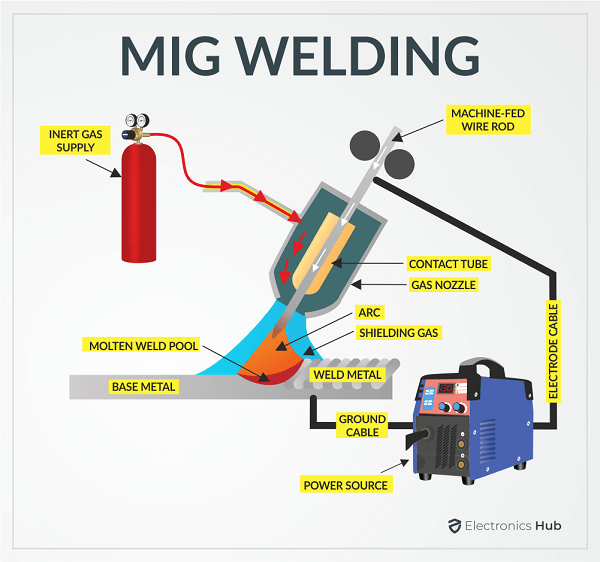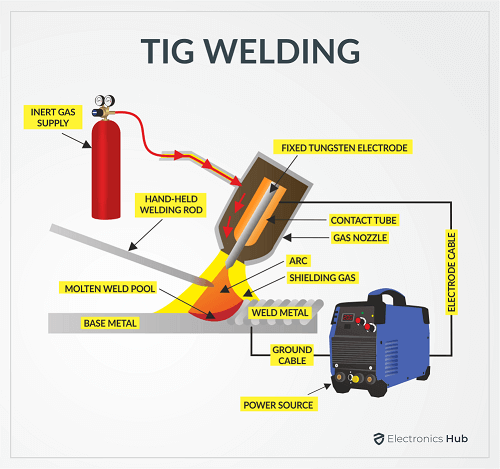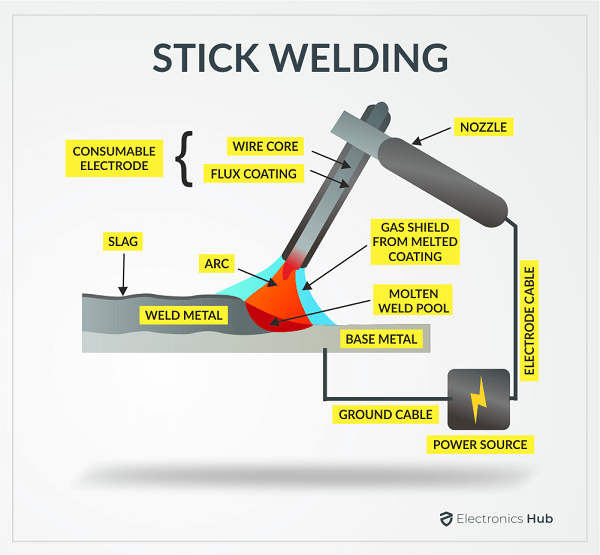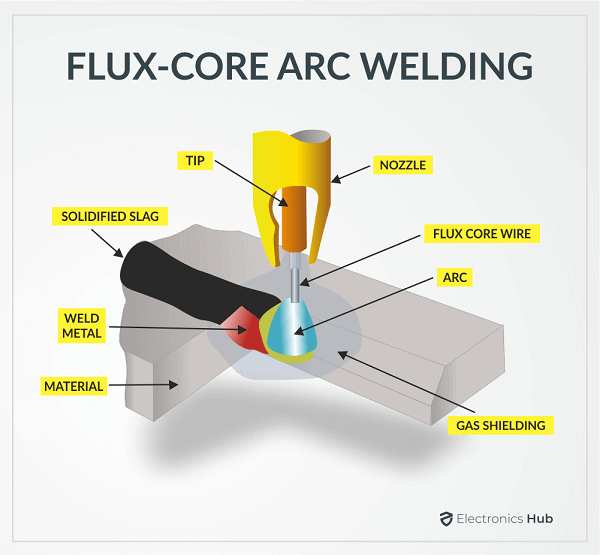These forms, however, are frequently classified into four classes. In this article, we’ll go into greater detail about the mechanics of each method and highlight their peculiarities. Continue reading to learn more about the four basic forms of welding and their applications. Welding is the process of melting and fusing different metal components. There are many welding processes, some of which you may be unfamiliar with. Several high-tech processes make use of electromagnets, lasers, and microwaves. Forging or melting metal using a flame, and then forging two pieces together with a hammer, are examples of low-tech procedures. The four most often used welding processes are listed below. There are other forms of welding methods, however, the four highly popular are as follows:
Here Are Some General Types of Welding Processes
They are all arc welding processes, which implies that an electrical circuit is completed when the electrode connects with the work object, building hold, and electrode. An arc is created by a pinch. Due to the hundreds of levels this electric arc goes, the metal melts and flows simultaneously. The cathode utilizes a filling steel that melds and permeates the surroundings to finish the gap and form a separate part of iron. Surface temperatures in the thousands of degrees Celsius affect the relation of chemicals with the air and substances such as oil or rust. Porosity, brittleness, corrosion, and potential failure are all caused by nitrogen and oxygen. To keep the melted weld splashing from the atmosphere and outdoor pollutants, every process permeates the arc region with inert gases that do not interact with more chemicals. The finished welds are significantly stronger, more reliable, and cleaner because they are not in contact with air while fusion occurs.
1. MIG Welding: Gas Metal Arc Welding (GMAW)
The shielding gas for MIG welding is provided by a compressed reactive gas bottle. The spark is created and filled by a cable that likewise melds. MIG welding is a plain technique of welding that even inexperienced welders may master. Although the technique is sometimes called Gas Metal Arc Welding, (GMAW). Metal inert gas welding abbreviation is MIG, this quick technique consumes the filling steel via the stick while vapours are released over it to keep it safe from the atmosphere. This means that it is not appropriate for outdoor use. Nevertheless, it is a versatile process that will be utilized to weld a variety of iron kinds at varying viscosities.
Advantages and Disadvantages
How It Works
⮚ Excellent heat control ⮚ Clean welds ⮚ Simple to grasp MIG Welding is the best approach if you need to weld quickly, are a newbie or need to keep the heat low. The sheltering gas combines a degree of complication and offers a superior temperature mechanism and a neat weld.
Usage
MIG Welding is another name for GMAW Welding. In this process, the electrode is a cable charged electrically that is constantly consumed into the weld from a motorised coil but standing inundated with sheltering vapours. The MIG Gun Welding lead unites the energy, has a hole for the cathode cable to slip into, and a gas cylinder for the MIG Torch Context.
Carbon dioxide is commonly utilised as a MIG Shielding Gas.
2. TIG Welding: Gas Tungsten Arc Welding (GTAW)
TIG Welding, also known as Heliarc & Gas Tungsten Type Arc Welding (GTAW), is the most traditional welding technology. The tungsten electrode used in this welding process is not consumable. It is one of those types of welding, which requires only 2 metals being combined and welded together and no filler metal. You can combine a filler metal, but you’ll need to feed it via hand. TIG welding necessitates using a gas tank to give the perpetual flow of gas required to secure the weld. This simply means that it is usually better done indoors, away from elements. TIG welding is generally a precise type of welding that generates good-looking welds that do not require cleaning because there isn’t any spatter. These qualities make it a complicated kind of welding that is best left to experienced welders.
Advantages and Disadvantages
How It Works
The Electrode is the fundamental difference between TIG and other techniques. The torch’s electrode is a short, point-sharpened tungsten rod. ⮚ Highest precision and feature ⮚ Capable of welding very delicate substances ⮚ There is no dross. The distinction is that the electrode is not burnt. Instead, the operator inserts a long rod of filler metal into the weld puddle with one hand while controlling the torch with the other. The weld puddle is eroding this metal rod. The electrode, like a flame torch, simply initiates and maintains the arc required to melt the metal. The operator’s torch competence, ability to control the heat level and ability to feed the filler rod at the optimal rate all play a key impact in the outcome. The TIG Torch Connection, similar to a MIG System but lacking a wire feeding mechanism, transfers pressurised inert gas to saturate the arc zone. TIG Welding commonly uses argon as a shielding gas.
Usage
TIG Welding is utilized when robust and neat welds are required. Various TIG-welded constructions are covered after construction, making maintenance difficult. Race car roll cages, high-end electronics cabinets, electric equipment, and aeroplane constructions are all examples. Another application for TIG is when the weld is constantly noticeable and involves a particular amount of visual influence or High- Tech Validation. Custom bodywork, expensive lawn furniture, and exposed hot rod frames are a few examples.
3. Stick Welding: Shielded Metal Arc Welding (SMAW)
Even though Welding was developed in the 1930s, it has been constantly renovated and improved now. Its popularity has continued due to its simplicity, ease of use, and inexpensive cost. Though, since it spatters rapidly, it does not supply the tidiest welds. Cleaning is usually required. Furthermore, the filler metal functions as a reusable electrode “Stick“. When the tip of the stick contacts the base metals, the electrode melts into the filler metal, generating an arc that generates the weld. When the Flux is applied to the stick, it produces a Gas Cloud that protects the metal from oxidation. The gas condenses on the metal as it cools and solidifies to form Slag. Because there is no gas involved, this procedure can be used outside even in adverse weather such as rain and wind. It is ideal for repairing equipment due to its excellent cleaning, painting, and Corrosion Qualities. Although it is not advised for thin metals, it is straightforward to weld a range of metals due to the availability of many different types of electrodes that can be swapped out. Stick welding has a steep learning curve and requires advanced skills.
Advantages and Disadvantages
How It Works
Stick Welding have long cable leads with an Electrode Holder on one end and a strong clamp on the other. They also have a source of power. The electrode is constructed of metal and appears like a Thick Wire. They come in a variety of metals and alloys. ⮚ Not prone to contamination ⮚ Almost any metal can be welded. ⮚ It brings up a long point. The diameter of the welding rod varies. It is determined by the thickness of the metal. Flux is a material that is heavily placed on welding rods and then burns in the arc to create a gas that shields the Welding Puddle. Slag, a thin, brittle coating created when the metal cools, must be chipped and brushed away.
Usage
Welding is done with a stick if at all possible. When the weld is difficult to access or when rust, oil, or other impurities are present at the Weld Joint, stick arc welding is suggested. It does well on the blade, melded iron, aluminium, stainless steel, and rough surfaces on Agricultural Instruments.
4. Flux Cored Arc Welding (FCAW)
This form of welding is related to MIG Welding. In existence, MIG welders are commonly also FCAW Welders. As with MIG welding, a cable that provides both the electrode and the filling steel is consumed through your wand. At this point, matters commence diverging. A flux core in the FCAW Wire produces a vapour barrier across the weld. As a result, there is no need for an external gas supply. FCAW is a High-Heat Welding process that works best with thicker, heavier metals. This is why it is extensively used in heavy machinery repairs. It is a prolific process with low waste. It is also cheap because no external gas is required. However, some remaining slag will need to be scraped off to achieve a beautiful, completed weld.
Advantages and Disadvantages
How It Works
The FCAW process employs a hollow wire loaded with flux, similar to the stick process, which employs an electrode covered in flux. ⮚ In windy conditions, it can be employed. ⮚ Thick steel is easily managed. FCAW, like MIG, inserts a spool of wire into the. Welding Lead Stick welders change the electrode every time the wire spool runs out, allowing you to weld faster.
FAWS-G and FAWS-S
Flux core welding is classified into two categories.
FCAW-S
The “S” stands for “Self-Shielded” and it is the highly often used flux core technology due to its low cost, ease of usage, and great effectiveness.
FCAW-G
The letter “G” implies the use of External shielding Gas in addition to the traditional flux core wire and is also called dual-shielded wire welding. When compared to the FCAW- S and MIG procedures, this approach generates a smoother and easier Control Arc.
Usage
Flux Core Welding is most commonly used by hobbyists, small businesses, and fabrication shops due to its superior penetration, precise temperature management, and ease to handle at a lower expense than MIG Welding.
Conclusion
You should now have a general knowledge of the various welding procedures. Various forms necessitate the purchase of costly specialised equipment to be performed by machine. Others can be done at home by a hobbyist for a low cost. If you want to buy a welder, read one of our recommendations evaluating the Best Welders for house usage. Other welding techniques exist, but these four are the most common. Without hesitation, ask any welders you know questions. Knowing what each process entails can assist you in making more important selections. Source: Types of Welding Comment * Name * Email * Website
Δ









![]()